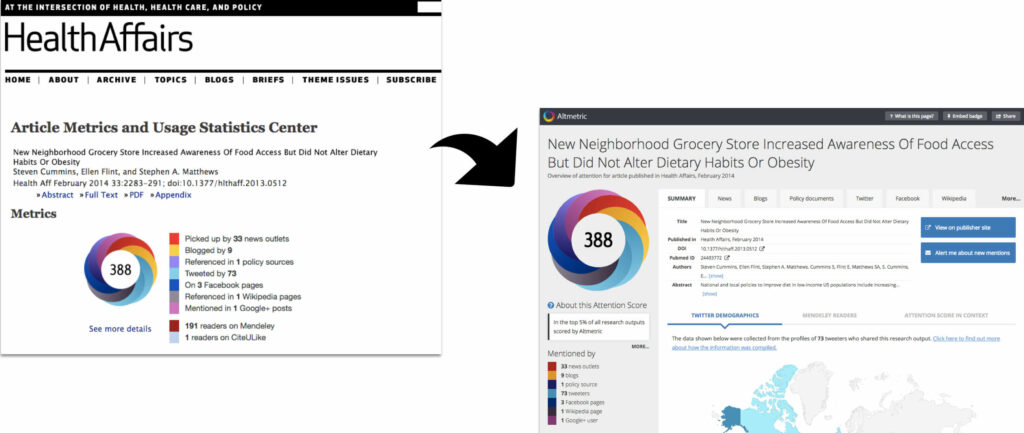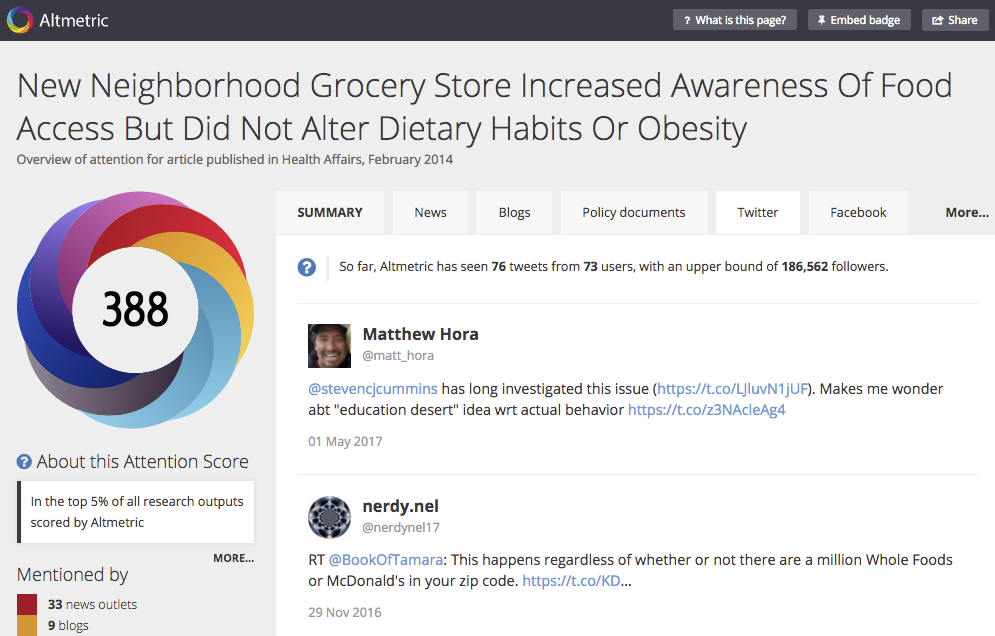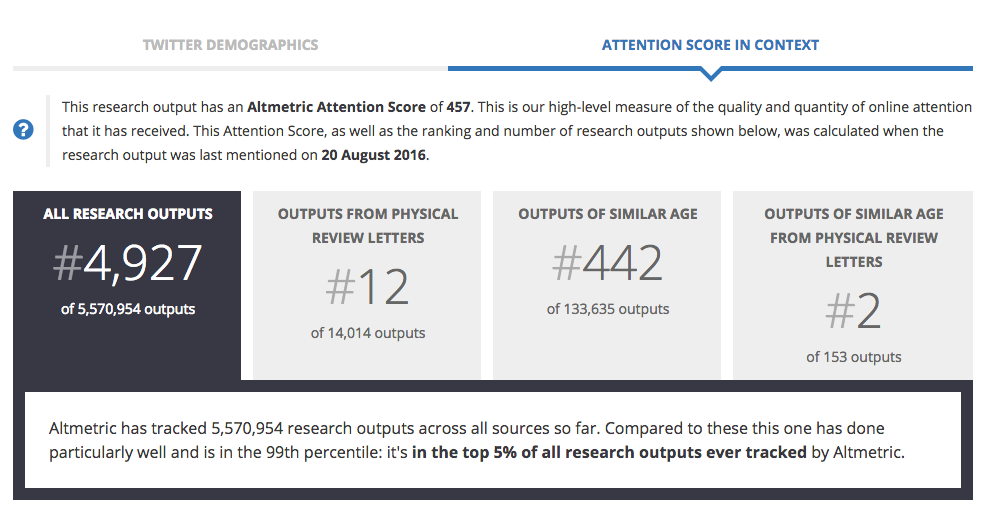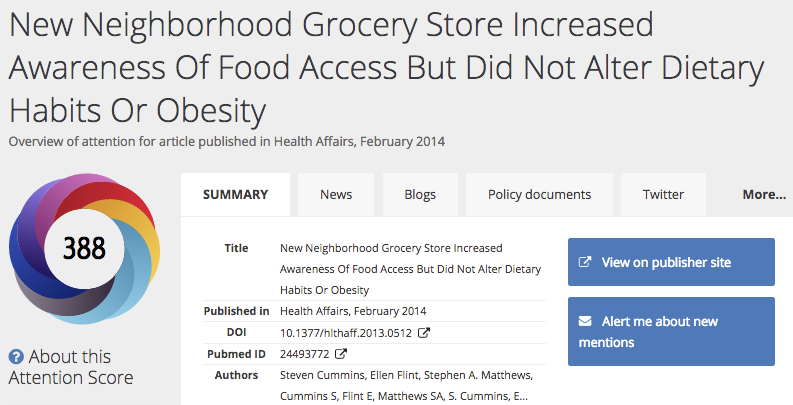Interpreting altmetrics

Lots of researchers tell us they love seeing and exploring the altmetrics for their work, but aren’t always sure what to take make of it, or what to do as a result of what they find. In this blog post we’ll provide some pointers for interpreting your altmetrics, and what you can look to do as a next step.
1. Finding the altmetrics for your content
There are several ways you can find altmetrics for your publications, and not necessarily just the metrics provided by Altmetric.com. Many publishers now include the Altmetric badges on their article pages, and others sometimes include information pulled from elsewhere, such as their own media or social monitoring service (check out PLOS and Mendeley for examples of this).
Where you do see the Altmetric badges embedded on a page you can click on them to access the full record of attention – the Altmetric details page – so you can see not just how much your work was talked about, but who was doing the talking and what they were saying.

Using the free Altmetric bookmarklet will also give you access to these pages for items that have a DOI, or if your institution subscribes to the Altmetric Explorer you can explore all of the mentions for over 9 million outputs in one place!
Whichever route you choose, the data will be updating in real-time, providing you with the latest insights on the conversations and engagement surrounding your work.
2. What is the data telling you?
Once you’ve found your altmetrics, the next thing to do is to critically evaluate the data. Which channels is your work receiving attention from? Has it been shared by an influential Tweeter, resulting in a broader reach? Is it being used by students or in Syllabi? Have policy makers picked it up and referenced it in their advice, or has someone thought it relevant enough to include in a Wikipedia article?

Determining who is talking about your research, and which channels they’re using to do so, can help you understand why they are likely giving it that attention, even if they don’t explicitly state it.
Another thing to consider is when your work received the attention it’s got – was it as soon as it was published, or did something happen later that meant it was surfaced again (for example a world event or topical news story?) Has funding changed in that area at the same time? Did someone do something that meant that it was suddenly noticed? You might be surprised by some of the attention that older work often gets, even if at the time it did not seem so notable.
One question that researchers often ask is whether or not their Altmetric Attention Score (the weighted count of attention an item has received) is any good. Although the score does not measure quality; of the research, the researcher, or the attention; it can be useful for measuring reach and visibility. A higher score = higher reach.
To help you see how the score your item has received compares to other work published at the same time (or in the same journal) the Altmetric details pages include a ‘score in context’ section. Taking note of the information in this tab can help you see if there might be opportunities for your work to be made more visible, or if in fact it’s way outperforming other content in your field.

If you’re publishing Open Access it can be interesting to keep an eye on how that impacts the attention your work receives – preliminary research has found that OA items sometimes get shared more than non-OA – another great reason to make your research open and discoverable!
3. How can you determine what to do next?
So, great, you’ve got a good understanding of how people are talking about your research, why they’re likely doing so, and how that compares in terms of volume of engagement to other work in your field. BUT, what are people actually saying about that other work? If it’s had less attention, who is it from? Are other researchers being picked up less by a general audience but more by policy makers? If it’s had more attention, is it attention from audiences that you would like to reach?
Using the tools outlined in section 1 you can start to explore the altmetrics for other work in your discipline, as well as your own. Browsing some recent issues of journals or the latest book releases will enable you to see how the level of visibility differs between publishers and title.
Based on what you uncover you can start to make a plan. Try answering these questions as a start:
- Do you feel the amount of visibility and engagement your work got was appropriate to the content?
- Who were you aiming would see and benefit from your work? From the altmetrics you have, does that seem to have been achieved?
- Compared with other research in your field, does the engagement your work has received seem high, average, or low? Are there areas where you might improve outreach?
- What ‘impacts’ or other outcomes did you hope for as a result of doing and publishing your work? Does the data provide any evidence of the extent to which you’ve reached those goals? (Perhaps, for example, you wanted to raise awareness of your topic in a certain country, and through the altmetrics for the publication you can see people from that region Tweeting about the work)
- Did you publish it open access, or would you perhaps want to consider doing so in future?
Altmetrics, like any metrics, are only valuable if you put them into context. Make sure you’ve got a good understanding of the qualitative data, and align what you find with what you want to achieve.
4. Take action!
Congratulations! You’ve published your work, taken a look at your early altmetrics, and given some consideration to whether or not you’ve got the result that you want. Now what? In some cases you could take immediate action: if you feel a past publication could’ve been more visible, why not share it now? You could identify some key bloggers to reach out to (based on the altmetrics for other publications in your field) or even just take the opportunity to re-share the work from your own social accounts.
If you’ve had something accepted but are still waiting on a publication date then now is the ideal time to try something new! Connect with your research support librarian, scholarly comms office or the PR team at your publisher to discuss how you might maximise the engagement for your work, or even just give some thought to what you’d like to achieve and build your own small plan. It doesn’t need to be extensive, and tools like Kudos can help make it even easier.
If you’re yet to submit then what you’ve learnt can help you shape future strategies: which publishers will share your work most effectively? Are they present on the channels and amongst the audiences you want to reach? What support do they offer for helping you share the work, and tracking the engagement?
Another thing to consider might be what research you make available. Altmetrics aren’t just for articles – they also pick up the attention for datasets, posters, images and all sorts of other research hosted on publisher websites, institutional repositories, preprint servers and other platforms. Sharing more and gathering evidence to demonstrate what the results of that were can help tell the bigger story of who you are as a researcher.
5. Make it easy
We all have loads of demands on our time, and keeping an eye on every little mention won’t always be top of your to-do list. Aim to make integrating altmetrics into your workflows as easy as possible – the Altmetric details pages have a link to sign up for alerts to be notified when new mentions of your publications occur, and if you’re using the Altmetric Explorer you can set up daily, weekly or monthly updates for any search.

If you check in on your citations from time to time, why not also take a moment to take a look over your altmetrics?
We hope you find this post useful! If you’d like some top tips for simple ways to make all of your work more visible click here to download our handy guide – and share your own in the comments below or on Twitter @altmetric!
Register here to receive the latest news and updates from Altmetric
